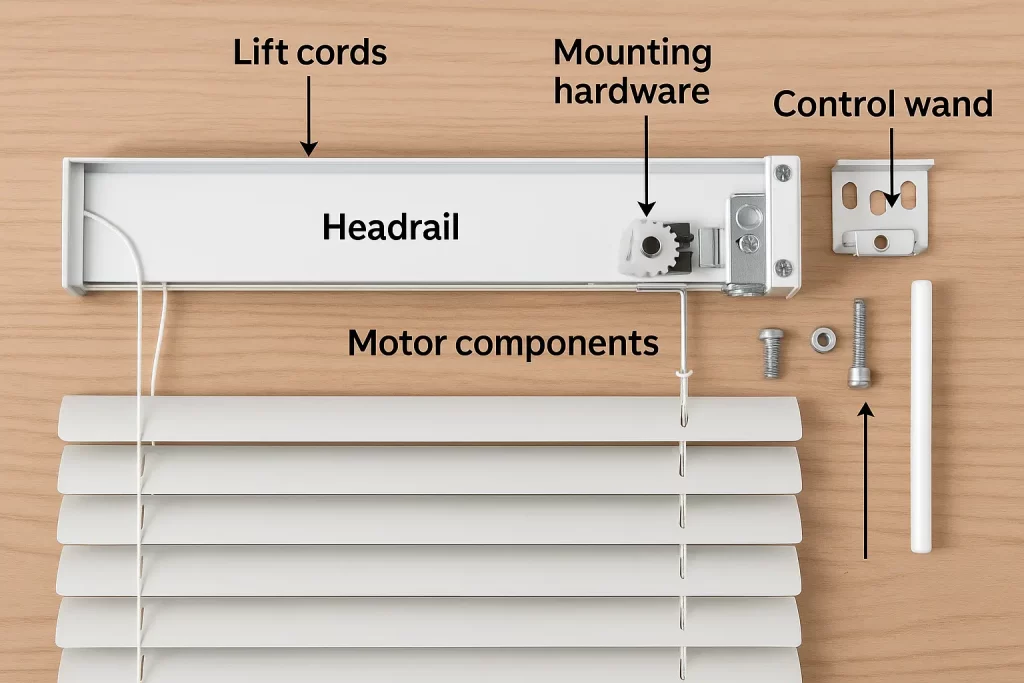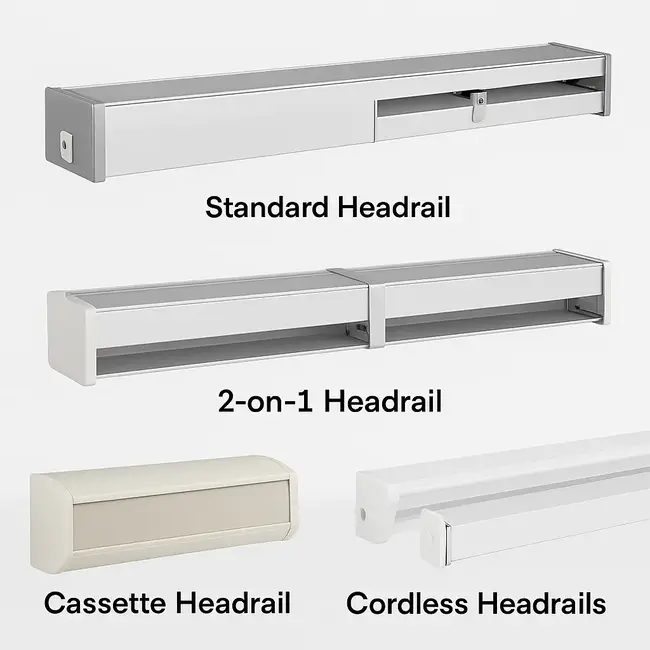Unsure what is a headrail on blinds? A short answer is: It is the ‘brain’ of your blinds or shades, responsible for controlling and coordinating all the moving parts that allow you raise, lower, and adjust your window treatment.
Also referred to as top rail, track, header, headbox, and cassette, a headrail is a horizontal hollow beam that houses the operational mechanisms responsible for the tilt, lift, drop, positioning, and movement of the blind. Fixed to the window frame or the section of the wall above it, a headrail serves as the foundation of the blind, anchoring all hardware components (mechanical parts and fittings) and ensuring smooth functionality.
A headrail is a relatively bulkier and sturdier component of window treatments, which is aligned parallel to the top of the window frame to ensure even, uncrooked, jam-free raising and lowering of the fabric. A headrail is typically 2 cm to 3.5 cm wider than the fabric to accommodate end-caps.
Understanding the design and dynamics of headrails is crucial when shopping for new window coverings, as they directly impact the interior decor, functionality, installation requirements, and budget.
Scroll on to learn about the key features, components, pros & cons, and FAQs about headrails for blinds and shades.
Key Features of a Headrail
- A Protective Covering – A headrail for blinds contains and protects internal components, such as cords, pulleys, brackets, and motor components (for motorized units).
- Structural Support – Provides structural support and stability to bear the weight of the fabric and ensure proper alignment of all parts, such as slats or fabric panels.
- Functional Support – A headrail allows for the tilting, opening, closing, and adjustment of the blinds for precise light control, privacy, energy efficiency, and other functional benefits.
- Versatility – They come with various design options for different types of blinds, such as rollers, romans, shutters, Venetians, verticals, cellulars, and faux wood blinds.
- Built-in Tilt Mechanism – Headrails of horizontally or vertically slatted blinds feature an integrated mechanism that allows the synchronized tilting of the slats at 180-degrees (i.e., you get 180 levels of light adjustment).
What Is a Headrail Made Of?
High-quality headrails are typically made of lightweight, heavy-duty materials, such as aluminum, with a bright dip metallic finish. They are also available in aluminum alloys and high-quality plastics (an affordable option).
Components of a Headrail

- Lift cords or cordless systems
- Motor components
- Mounting hardware (brackets, screws, and nuts & bolds)
- Control wands (an optional components)
Headrail: Pros & Cons
Pros
- Space-Optimized Design – Nowadays smart, robust headrails are available on the window blinds market, which typically measure 2 to 3 inches in depth, allowing them to be fitted inside window frames for a sleek, minimalist, built-in look.
- Easy, Consistent Up/Down Motion – A cut-to-size, customized, and properly installed headrail ensures easy and consistent adjusting, tilting, lifting, and sliding mechanisms for your window treatments.
- Decorative Flair – Modern headrails come in metallic finishes, fabric wraps, and color coordinating options, so you can choose your favorite options to add a personalized decorative flair to the entire aesthetic of your home.
- Helps the Fabric Fit Edge to Edge – Holding the fabric weight and keeping it in a tight/stretched position, a headrail helps prevent gaps along the sides, improving insulation and energy efficiency of your home.
- Can Fit Arched Windows – Headrails are available in curved designs to cover windows with rounded tops, while maintaining an even look and ensuring that the slats open and close without obstruction.
- Add Durability to Your Window Treatments – If you choose high-quality headrails, they’ll better protect the internal corded, cordless, or motorized mechanisms (in the case of motorized shade systems), prolonging your blinds’ life by 3 to 4 years!
- Child Safety – Exposed mounting hardware on easy-to-reach windows can pose a safety risk for kids.
Cons
- Higher Initial Cost – even the cheapest non-motorized headrails will add at least $20 to the total price package of the window covering.
- Operational Issues – Frequent use can cause the internal components to tangle or snap over time, making the headrail non-operational.
- Risk of Noise Pollution – headrail track systems of extra-wide (100 to 120”) vertical blinds can be noisy.
Design Tip for Multiple Windows in a Row
Our customers’ data over the last 4 years suggests homeowners and businesses having 2, 3 or 4 large windows in a row, mostly go for 2-on-1, 3-on-1, or 4-on-1 headrails. It will give your window coverings a sleeker, continuous look, while also saving you on additional hardware and installation costs.
7 Popular Types of Headrails for Blinds

- Standard 1-on-1 Headrails: A basic headrail design that holds a single horizontal or vertical blind, and houses its manual controls, such as lift cords and tilt wands.
- 2-on-1 Headrail: Designed to connect two large adjacent window treatments, this acts as a single continuous headrail, running the collective width of two windows for a unified appearance.
- 3-on-1 Headrail: Extended headrail, ideal for three large picture windows or bay window configurations.
- Continuous Headrails: Commonly used in RV camper trucks, continuous headrails provide uninterrupted horizontal lines across multiple side-by-side windows for a seamless architectural cohesion and simultaneous, synchronized operation.
- Cassette Headrail: Used for Roman shades, roller shades, and zebra blinds, it is a decorative headrail with a sleek cover. A cassette headrail conceals the internal operational mechanisms for a cleaner, polished appearance.
- Cordless Headrails: Found in cordless window coverings, this type of headrail eliminates hazardous lift cords and uses spring-operated or one-touch-lift mechanisms for kid-safe and seamless functionality.
- Motorized Headrails: Used in automatic or smart motorized blinds, it contains electronic components that allow operation through wireless remote controls, voice commands, home automation systems, or smart devices.
Typical Price Range
New window treatments come with headrails as an integral component, without separate pricing. For example, if you buy Essential 1 inch Cordless Privacy Mini Blinds for your 24” x 36” window, you will need to pay around $50 to $60, including the cost of the headrail. However, if you are looking for a replacement for your damaged or non-functional headrails, you should allocate a $50 to $150 budget, based on type, quality, and size. For example, a 96” aluminum headrail for vertical blinds will cost around $100 to $130.
How Do You Measure Headrail?
- Step 1: Collect tools like a steel tape measure and a pencil and a piece of paper (to record values). If the window top is hard to reach, you’ll also need a ladder.
- Step 2: Determine the headrail mounting position, either 3-4 inches above the frame (for an outside mount) or inside the frame (for an inside mount). In the case of an outside mount, also extend the headbox 3-4 inches beyond the window openings at both ends (i.e., total 6 to 8 inches) for proper light coverage.
- Step 3: Take measurements using the steel tape measure, making sure the headrail is aligned at 180-degree for smoother, uncrooked operation.
Frequently Asked Questions about Headrails on Blinds
What is the top part of a blind called?
The top-most part of a blind is typically called a headrail that houses and protects the mounting hardware, tilt mechanism, and cords, motor, or some other lift apparatus. Some blinds also have additional enclosures, such as a valance, pelmet, headbox, or cornice.
How to install headrail for vertical blinds?
- Step 1: Position the headrail along with brackets on the installation surface.
- Step 2: Mark the spots for screw holes.
- Step 3: Drill holes using a drill bit, not more than 3mm in size.
- Step 4: Mount the headrail, making sure the channel in front of it is sealed in the bracket’s hook. Rotate it back so that it perfectly snaps into place.
- Step 5: Secure the bottom chain and the bottom rail using the hold-down brackets.
- Step 6: Install valance (if you have one) and test operation. Make readjustments, if needed.
What is a turned headrail on blinds?
A turned headrail on blinds is an optional no charge customization that reduces the standard mounting depth, height, and projection of the window covering. Depth and height are swapped to make the headrail shallower (¾”) and taller (1-½”) so it can be easily accommodated in the shallow mounting depth of windows and doors.
Need More Help?
Need design consultation or any other help related to a headrail? We invite you to 24/7 live chat. Or contact us at (800) 863-6109, or customerservice@affordableblinds.com for further assistance.

Leave a Reply